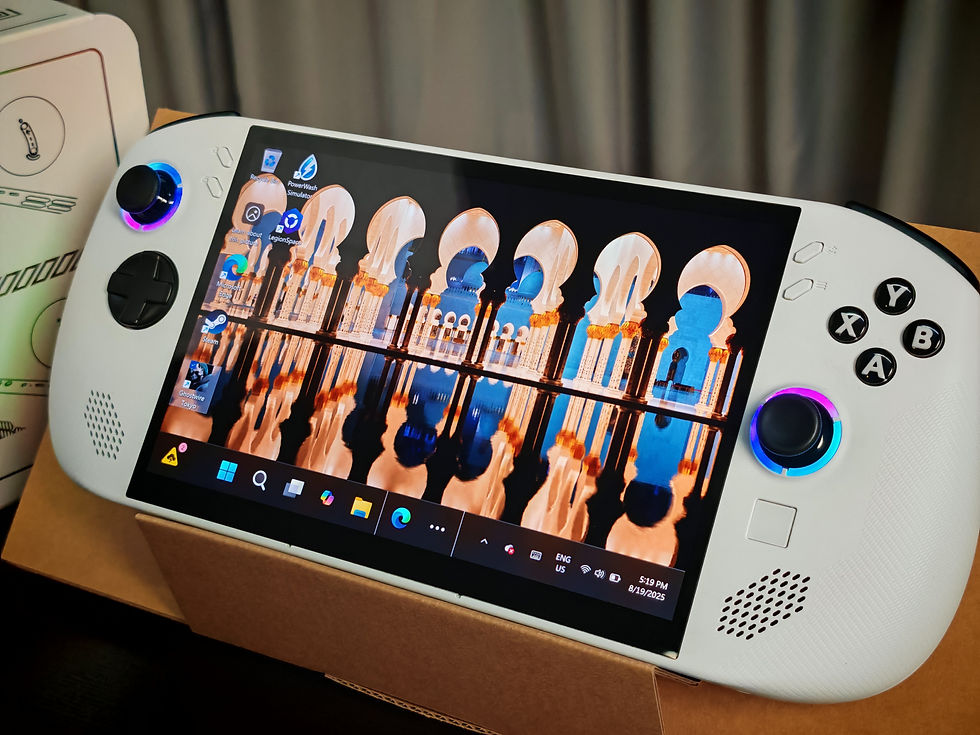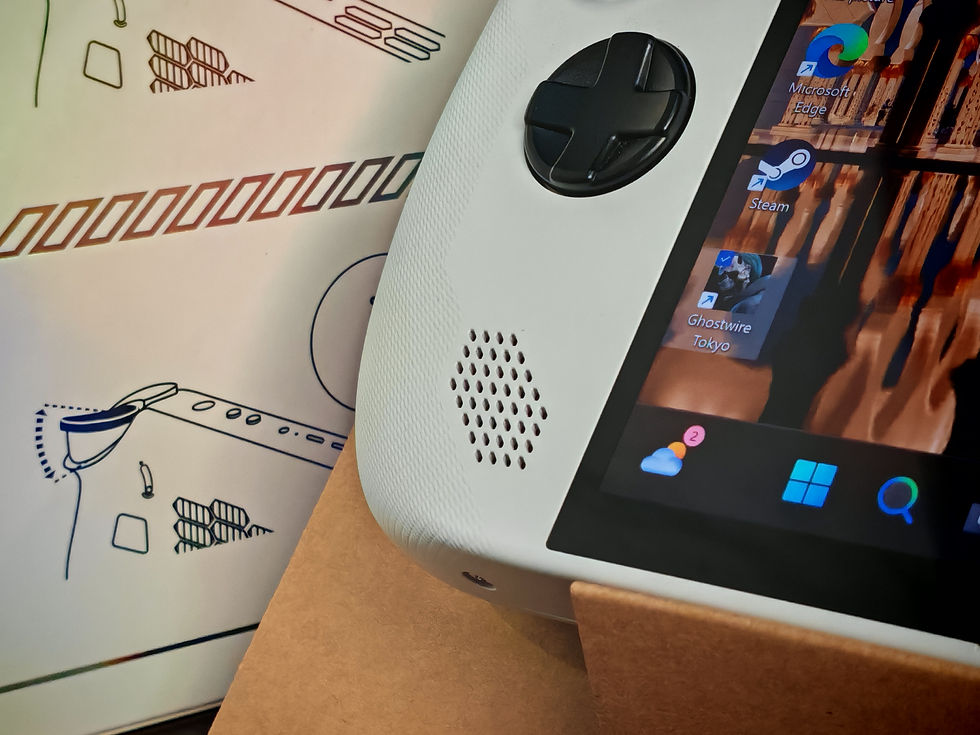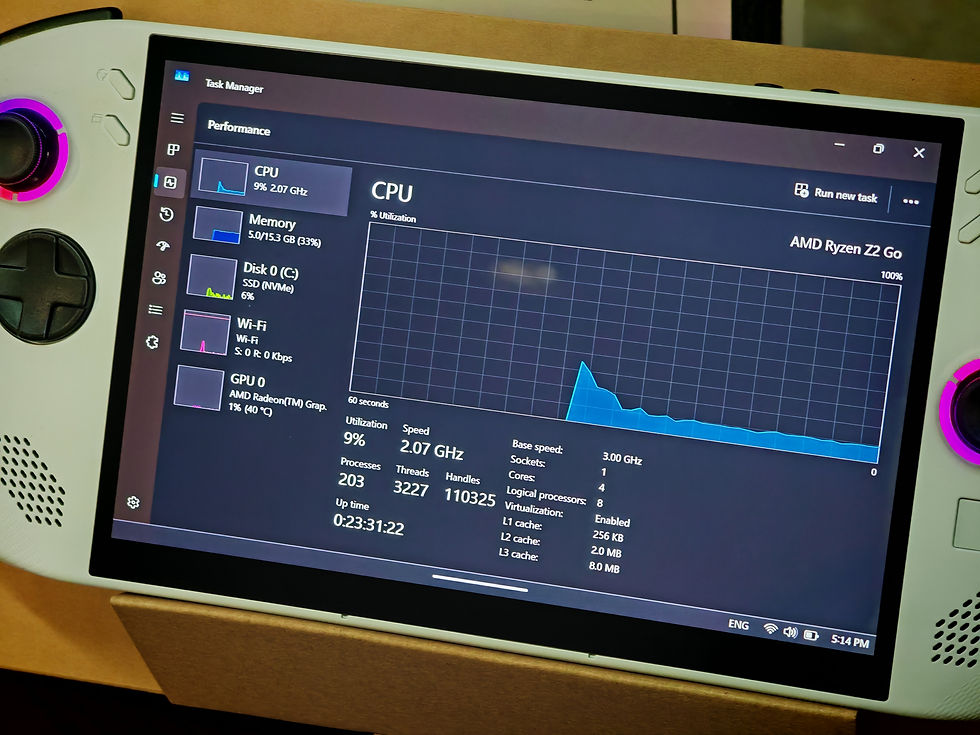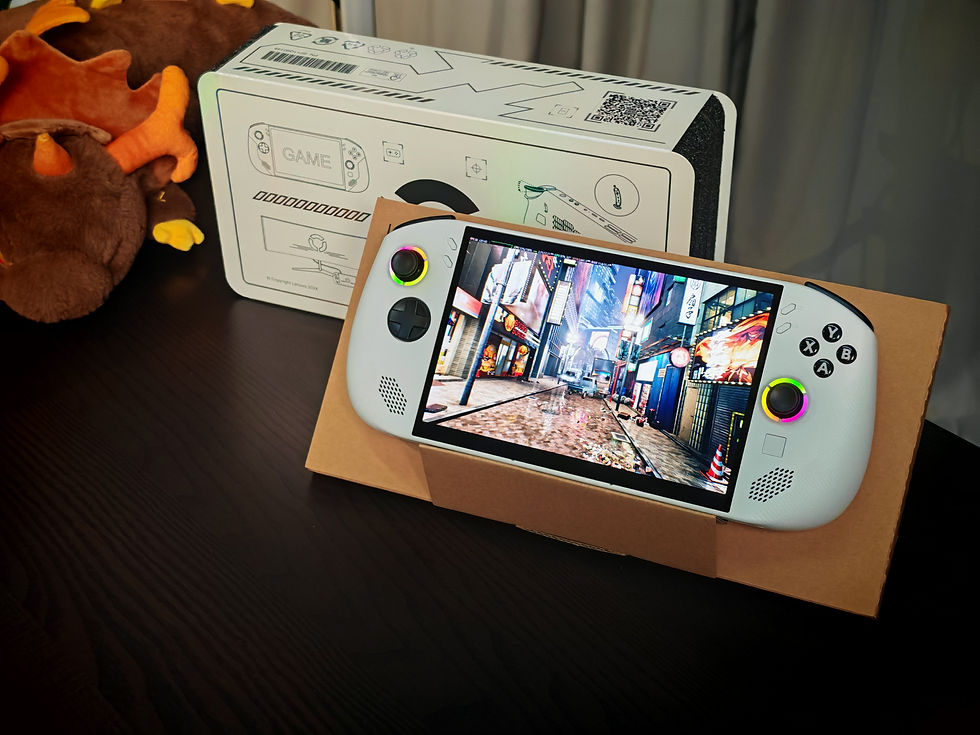Lenovo Legion Go S Review: A Refined Contender in Handheld Gaming
- hoeyeen
- 3 days ago
- 8 min read
The handheld PC gaming market has exploded in recent years, with devices like the Steam Deck and ROG Ally carving out their own identities. When Lenovo entered the scene with the original Legion Go, it did so with a bold, unique, but somewhat polarizing design. Now, with the launch of the Legion Go S, Lenovo has returned with a more focused, streamlined, and arguably more mature device. Today we will take a better look at what the Legion Go S gets right, what feels meh, and how it stacks up against the competition.

A New Approach to Design and Ergonomics
The most apparent change in the Legion Go S is its new unibody design. Moving away from the original's detachable "Joy-Con"-style controllers, the 'S' model adopts a fixed, all-in-one form factor similar to the Steam Deck and ROG Ally. This change is a major win for ergonomics, resulting in a device that is lighter and has a more solid, comfortable feel in hand. The grips are well-contoured and feature an anti-slip texture, making it feels more balanced in the hands and easy to hold for extended periods.

The physical controls have also been upgraded. The Hall effect joysticks with RGB lighting provide smooth, precise movement with no drift, while the D-pad is has a better tactile feedback, making it a key upgrade for fighting game enthusiasts. The triggers have an adjustable switch, allowing you to quickly change the depth of the trigger pull for different game genres, which is minor but welcome feature for serious gamers.

The one notable ergonomic compromise is the single, small trackpad on the right side, which, while useful for navigating the desktop, it is far less effective than the Steam Deck's haptic trackpads for in-game use, feeling more like a last-minute addition than a core feature. At a weight of approximately 740g, it is significant lighter than the Legion Go's 854g and feels much more well-balanced in the hand. Though its still much more heavier than the Steam Deck and ROG Ally series, the larger size does justify the additional weight.

The device also features a versatile array of ports, including two USB4 Type-C ports, a microSD card reader, and a 3.5mm audio jack. The inclusion of two USB4 ports is a major advantage, offering high-speed data transfer (up to 40 Gbps), video output, and power delivery all through a single, reversible connector. This allows you to connect multiple high-bandwidth peripherals, such as an external display and a fast SSD, simultaneously. The microSD card reader provides an affordable and convenient way to expand the device's storage for your game library and other files. Finally, the dedicated 3.5mm audio jack ensures low-latency, high-quality analog audio, which is crucial for competitive gamers who want a reliable, lag-free audio connection to their headphones.

Display: A Backward Move with a Purpose
The original Legion Go featured a large 8.8-inch, 2560x1600 IPS display with a 144Hz refresh rate. The Legion Go S pares this back to an 8-inch, 1920x1200 LCD touchscreen with a 120Hz refresh rate. While this might seem like a step backward on paper, it's actually quite a practical and welcome change. The new resolution is a much better match for the AMD Ryzen Z2 Go's performance, as very few titles could realistically run at the original's native 1600p resolution, not to mention the difference when the display size is this small. And given most other gaming handhelds feature a 7-inch display, this is still pretty much an advantage on the Legion Go S, as an inch of difference on such a form factor is actually pretty huge.

The new display also includes Variable Refresh Rate (VRR) support, a crucial addition that was missing from the first model. VRR helps to smooth out gameplay by matching the display's refresh rate to the game's frame rate, reducing tearing and stuttering, a common issue on handhelds where performance can fluctuate. The 8-inch screen still feels expansive and vibrant, and the slightly reduced bezels make for a more immersive experience. The display also boasts 100% sRGB color accuracy and a peak brightness of 500 nits, providing excellent clarity and vivid colors, though it doesn't quite match the vibrant, deep blacks and HDR capabilities of an OLED panel. The front-firing stereo speakers are decent for a handheld but won't provide a truly immersive audio experience, making headphones a recommended accessory when the audio cues are necessary.

Performance: A Surprising Step Back
Perhaps the most puzzling decision with the Legion Go S is its choice of processor. While the original Legion Go was powered by the formidable Ryzen Z1 Extreme, the Legion Go S uses the newer but less powerful AMD Ryzen Z2 Go. This is a 4-core, 8-thread processor, a significant step down from the Z1 Extreme's 8 cores and 16 threads. In raw performance benchmarks, the Z2 Go consistently falls behind its predecessor and other competitors which uses the Z1 Extreme. According to sources online, there is a Z1 Extreme model for the Legion Go S, which give users more options for a better performance, but apparently that doesn't seem to be available in Malaysia locally so if you're in the market for one of these, you might need to take note of this.
The Legion Go S is offered with up to 32GB of LPDDR5X-6400MHz RAM and up to 1TB of storage. While 32GB of RAM is an impressive figure for a handheld, its practical benefit for most games is actually limited. For many AAA titles, the performance bottleneck will be the integrated AMD Radeon graphics, not the system RAM. The extra memory is more of a "future-proofing" feature, providing a cushion for memory-intensive applications and ensuring the device remains capable for years to come.

The thermal design has been improved, with a new cooling system that efficiently dissipates heat and keeps the device from becoming uncomfortably warm during gameplay. However, users should be prepared to adjust graphical settings in demanding AAA games to achieve a smooth and consistent frame rate. For example, titles like Cyberpunk 2077 or Ghostwire: Tokyo may require dropping the resolution or using upscaling technologies like AMD's FidelityFX Super Resolution (FSR) to reach a playable frame rate. For less demanding indie and mid-tier games, the device does handle all of them flawlessly.
Windows 11 VS SteamOS
Perhaps the most important decision for a potential buyer is which operating system to choose, as the Legion Go S is available with both Windows 11 and SteamOS.
The Windows version, which is the model I'm testing, offers unparalleled flexibility. It provides access to a full PC gaming library, allowing you to install games from any storefront, including Steam, Epic Games Store, GOG, and the Microsoft Store. This means there are no compatibility issues with anti-cheat software or other platform-specific limitations. However, this flexibility comes at a cost. Windows 11 on a handheld device remains a mixed bag. The UI is not optimized for a handheld form factor, making navigation with a controller or the small touchscreen clunky and frustrating. The "sleep" mode is also a point of frustration, as the device may not suspend properly and drain its battery.

For that, Lenovo's custom front-end software, Legion Space, aims to mitigate these issues by creating a console-like launcher. While the software has seen many improvements since the original Legion Go's launch, it can still be slow and temperamental, occasionally missing game art or being sluggish to launch. For a seamless experience, many users still rely on third-party launchers or tweaks to get the best performance.
The SteamOS version, on the other hand, provides a seamless, console-like experience. Optimized specifically for handheld gaming, SteamOS offers a smooth user interface, a superior sleep/resume function, and a significant performance advantage as the SteamOS version consistently delivers higher frame rates and better battery life. While its primary focus is the Steam library, Valve has confirmed official support for the Legion Go S, ensuring long-term updates and compatibility. The main trade-off is that some games with anti-cheat software and titles from other launchers may not work without significant tinkering. So if your main game Library is Steam, and you just want to play games (which is pretty much the purpose of a gaming handheld) , the SteamOS version is pretty much a no-brainer.
Battery and Charging: The Power Question
The Legion Go S is equipped with a 55.5Wh battery, which is a decent size for a handheld of this type. However, the actual battery life in a real-world scenario is highly dependent on the game being played and the power settings used.
For demanding AAA games running at higher TDP settings, you can expect a runtime of approximately 90 minutes to 2 hours, depends on your graphic settings. For less demanding indie titles or older games, especially when the TDP is lowered and the display's refresh rate is adjusted, you can get a significantly longer battery life, often in the range of 3 to 4 hours or more. The Windows version's background processes can be a drain, while the more optimized SteamOS version generally delivers better efficiency and longer play sessions.

To mitigate this, the device includes a 65W charger with Rapid Charge Pro technology. This allows the battery to charge from 0% to 70% in just about 30 minutes, or 0% to 100% in around 80 minutes. This feature is a crucial part of the Legion Go S experience, as it allows for quick top-ups between gaming sessions. For extended travel or serious gaming on the go, a high-wattage power bank is a recommended accessory.
The Gaming Experience: An Opinionated Look
My personal experience with the Legion Go S was a tale of two halves. On one hand, the hardware itself is a joy to hold and use. The improved ergonomics and the high-quality, albeit lower-resolution, display make gaming feel premium and comfortable. Playing titles like Hades or Stardew Valley felt perfect, with the screen's size and clarity making every detail pop.
On the other hand, attempting to play more recent, graphically demanding games was a constant struggle. Frame drops and a need for constant settings adjustments broke the immersive "pick up and play" nature of handheld gaming. The performance gap between the Legion Go S and its rivals, which are often priced similarly or even lower, is a major concern. The loud fan noise under load also detracts from the experience, making headphones a necessity for serious gaming.
Overall, the Legion Go S feels like a device with a fantastic physical body held back by a few puzzling internal decisions and the fundamental limitations of a full Windows OS on a handheld.

Conclusion
The Lenovo Legion Go S is a significant improvement over the original in terms of design, comfort, and display technology. The non-detachable controllers and improved ergonomics create a much more practical and enjoyable device. However, the surprising choice of a less powerful processor holds it back from truly competing with its high-end rivals. It's a fantastic device for indie games and older titles, but it struggles to be a flagship AAA machine.
The choice of operating system is also critical. For the enthusiast who values maximum compatibility and is willing to tinker with settings and drivers, the Windows 11 version offers a robust and versatile platform. It provides access to your entire PC library in a portable format. For the gamer who prioritizes a smooth, "pick-up-and-play" experience and a superior battery life, the SteamOS version is the obvious and highly recommended choice.
Ultimately, the Legion Go S is a great device, but its full potential is best realized with an operating system purpose-built for its unique form factor. And for the device itself, if you are a fan of Lenovo's design and value ergonomics and a beautiful display over raw power, the Legion Go S is a solid choice. If your local market offers the choice of Z1 Extreme processor on the Legion Go S, all that left to decide is just your budget.










Comments